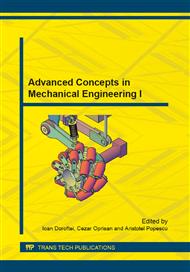p.381
p.389
p.395
p.401
p.407
p.413
p.417
p.423
p.429
Analysis and Simulation of Gait Types with Blocked Joints
Abstract:
The analysis of gait cycle represents for the professional in biomechanical field a source of information concerning the normality status, comfort degree in carrying out various activities, existence and manifestation of some loco-motor malfunctions, manner and degree of recovery/rehabilitation after surgery and many other applications. From this point of view, computerized simulation with respect to the anthropometric dimensions and the type of action represents an efficient and flexible manner for analysis and evaluation or even for creating a comparative algorithm between different situations or stages of motions performed by the locomotion system. Thus, some general aspects concerning the human locomotion system, the physiological and anatomical limits are presented in the first part of the paper. The analysis and simulation methodology for various gait types, also the experimental system used for recording and then processing the data obtained from these simulations are described in the second part of the paper. In order to complete the developed structure, these options of gait cycle were simulated by the computer, using dedicated software, either by blocking the hip joint or the knee joint, then they were correlated with the normal ones. The results and conclusions of these simulations and recordings on a target group of 10 subjects without locomotion malfunctions but simulating the blocked joints were presented in the final part of the paper.
Info:
Periodical:
Pages:
407-412
Citation:
Online since:
October 2014
Authors:
Keywords:
Price:
Сopyright:
© 2014 Trans Tech Publications Ltd. All Rights Reserved
Share:
Citation:


